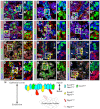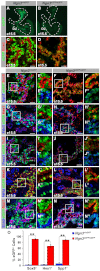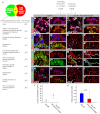A Notch-dependent molecular circuitry initiates pancreatic endocrine and ductal cell differentiation
- PMID: 22675211
- PMCID: PMC3383226
- DOI: 10.1242/dev.078634
A Notch-dependent molecular circuitry initiates pancreatic endocrine and ductal cell differentiation
Abstract
In the pancreas, Notch signaling is thought to prevent cell differentiation, thereby maintaining progenitors in an undifferentiated state. Here, we show that Notch renders progenitors competent to differentiate into ductal and endocrine cells by inducing activators of cell differentiation. Notch signaling promotes the expression of Sox9, which cell-autonomously activates the pro-endocrine gene Ngn3. However, at high Notch activity endocrine differentiation is blocked, as Notch also induces expression of the Ngn3 repressor Hes1. At the transition from high to intermediate Notch activity, only Sox9, but not Hes1, is maintained, thus de-repressing Ngn3 and initiating endocrine differentiation. In the absence of Sox9 activity, endocrine and ductal cells fail to differentiate, resulting in polycystic ducts devoid of primary cilia. Although Sox9 is required for Ngn3 induction, endocrine differentiation necessitates subsequent Sox9 downregulation and evasion from Notch activity via cell-autonomous repression of Sox9 by Ngn3. If high Notch levels are maintained, endocrine progenitors retain Sox9 and undergo ductal fate conversion. Taken together, our findings establish a novel role for Notch in initiating both ductal and endocrine development and reveal that Notch does not function in an on-off mode, but that a gradient of Notch activity produces distinct cellular states during pancreas development.
Figures







Similar articles
-
Impact of Sox9 dosage and Hes1-mediated Notch signaling in controlling the plasticity of adult pancreatic duct cells in mice.Sci Rep. 2015 Feb 17;5:8518. doi: 10.1038/srep08518. Sci Rep. 2015. PMID: 25687338 Free PMC article.
-
Notch-mediated post-translational control of Ngn3 protein stability regulates pancreatic patterning and cell fate commitment.Dev Biol. 2013 Apr 1;376(1):1-12. doi: 10.1016/j.ydbio.2013.01.021. Epub 2013 Jan 29. Dev Biol. 2013. PMID: 23370147
-
Ectopic pancreas formation in Hes1 -knockout mice reveals plasticity of endodermal progenitors of the gut, bile duct, and pancreas.J Clin Invest. 2006 Jun;116(6):1484-93. doi: 10.1172/JCI27704. Epub 2006 May 18. J Clin Invest. 2006. PMID: 16710472 Free PMC article.
-
The role of SOX9 transcription factor in pancreatic and duodenal development.Stem Cells Dev. 2013 Nov 15;22(22):2935-43. doi: 10.1089/scd.2013.0106. Epub 2013 Aug 2. Stem Cells Dev. 2013. PMID: 23806070 Review.
-
Sox9: a master regulator of the pancreatic program.Rev Diabet Stud. 2014 Spring;11(1):51-83. doi: 10.1900/RDS.2014.11.51. Epub 2014 May 10. Rev Diabet Stud. 2014. PMID: 25148367 Free PMC article. Review.
Cited by
-
Flavin Adenine Dinucleotide (FAD) and Pyridoxal 5'-Phosphate (PLP) Bind to Sox9 and Alter the Expression of Key Pancreatic Progenitor Transcription Factors.Int J Mol Sci. 2022 Nov 14;23(22):14051. doi: 10.3390/ijms232214051. Int J Mol Sci. 2022. PMID: 36430529 Free PMC article.
-
Impact of Sox9 dosage and Hes1-mediated Notch signaling in controlling the plasticity of adult pancreatic duct cells in mice.Sci Rep. 2015 Feb 17;5:8518. doi: 10.1038/srep08518. Sci Rep. 2015. PMID: 25687338 Free PMC article.
-
Sox9 regulates alternative splicing and pancreatic beta cell function.Nat Commun. 2024 Jan 18;15(1):588. doi: 10.1038/s41467-023-44384-8. Nat Commun. 2024. PMID: 38238288 Free PMC article.
-
Deciphering early human pancreas development at the single-cell level.Nat Commun. 2023 Sep 2;14(1):5354. doi: 10.1038/s41467-023-40893-8. Nat Commun. 2023. PMID: 37660175 Free PMC article.
-
Adaptive Landscape Shaped by Core Endogenous Network Coordinates Complex Early Progenitor Fate Commitments in Embryonic Pancreas.Sci Rep. 2020 Jan 24;10(1):1112. doi: 10.1038/s41598-020-57903-0. Sci Rep. 2020. PMID: 31980678 Free PMC article.
References
-
- Apelqvist A., Li H., Sommer L., Beatus P., Anderson D. J., Honjo T., Hrabe de Angelis M., Lendahl U., Edlund H. (1999). Notch signalling controls pancreatic cell differentiation. Nature 400, 877-881 - PubMed
Publication types
MeSH terms
Substances
Grants and funding
LinkOut - more resources
Full Text Sources
Other Literature Sources
Molecular Biology Databases
Research Materials

